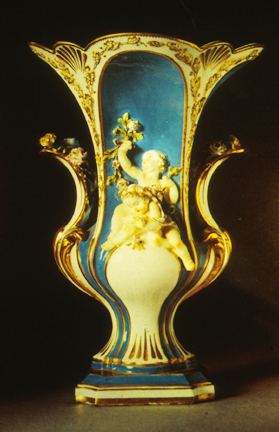
'Vincennes' Vase, Sèvres Porcelain, France 1753 CE
Soft Paste Porcelain with 'bleu celeste' overglaze enamel and luster
ART 198 - HISTORY OF WORLD CERAMICS
| While soft paste porcelain had been made earlier in France at both St. Cloud and Chantilly, it was at Sèvres that soft paste porcelain reached its height, and Sèvres would become the most famous manufacturer in Europe. Founded in Vincennes in 1740 by Claude-Humbert Gérin, Sèvres initially began producing work very much in the style of Meissen, but very soon, the work made there assumed its own style, and Louis XV soon granted Sèvres the royal license to produce 'porcelain in the Saxon manner.' This elaborate two-handled vase, designed by the silversmith, Jean Claude Duplessis is representative of the early production. This piece was decorated by Antoine Caton, and displays one of Sèvres' distinctive overglaze colors, called 'bleu celeste,' or celestial blue. Other colors were 'bleu lapis' (a deep blue-black), vert (green), noir (black), and rose (pink). In addition to the rich overglaze, Sèvres always used generous amounts of gold luster. | 'Vincennes' Vase, Sèvres Porcelain, France 1753 CE Soft Paste Porcelain with 'bleu celeste' overglaze enamel and luster |
|
|